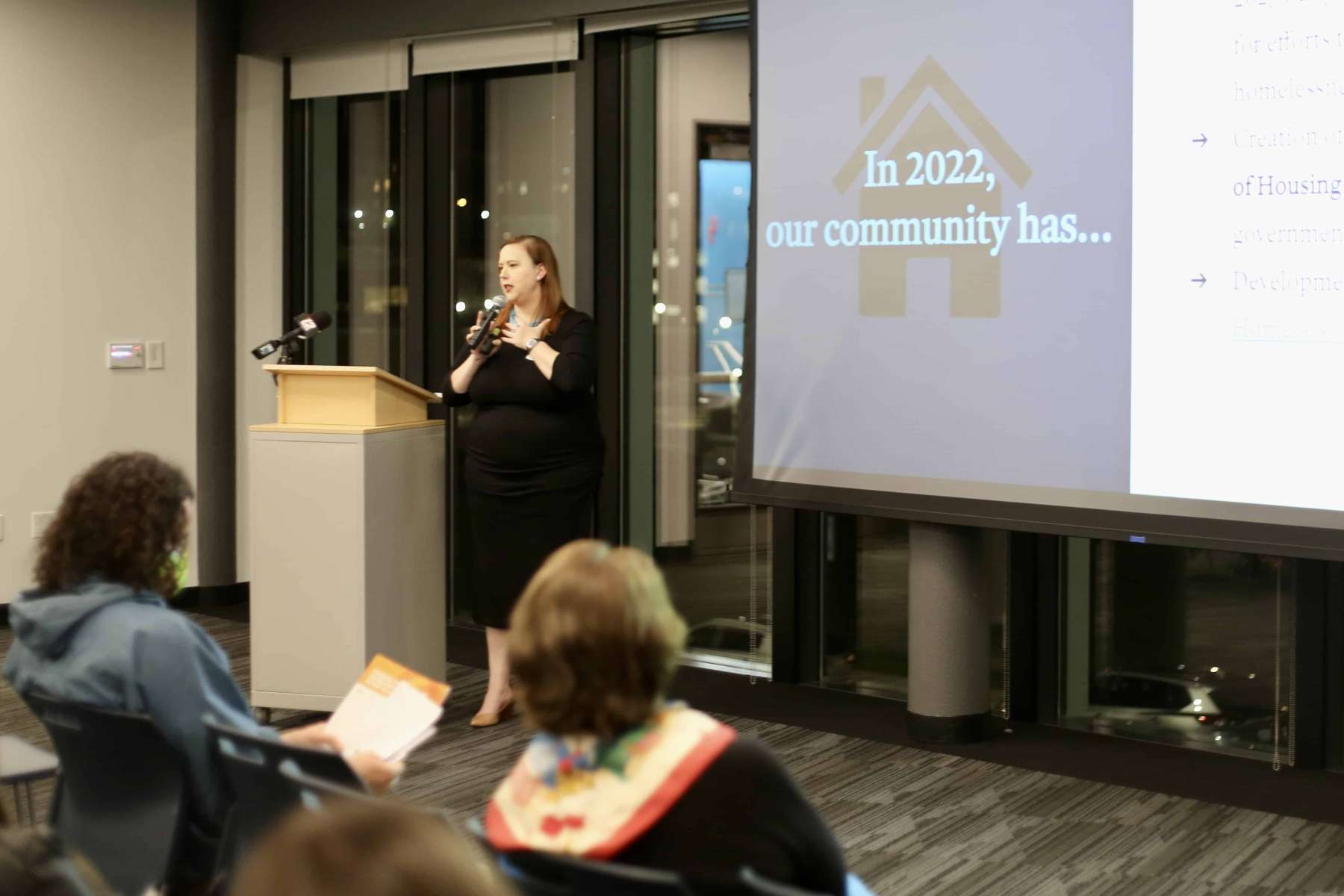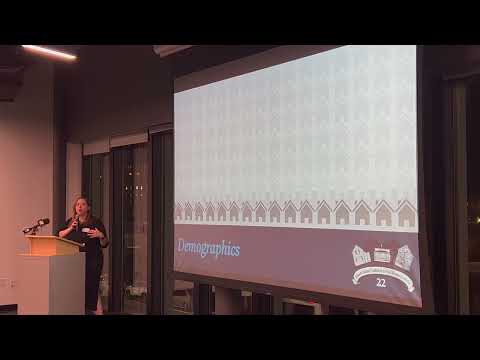Rhode Island Coalition to End Homelessness delivers 2022 address
The Rhode Island Coalition to End Homelessness delivered its first ever State of Homelessness Address in the CIC Providence Building on Dyer Street Monday evening. The event presented and highlighted local and state-wide data on homelessness gathered by Coalition staff and partners.
November 15, 2022, 1:11 pm
By Steve Ahlquist
The Rhode Island Coalition to End Homelessness delivered its first ever State of Homelessness Address in the CIC Providence Building on Dyer Street Monday evening. The event presented and highlighted local and state-wide data on homelessness gathered by Coalition staff and partners.
The event was emceed by Louisa D’Ovidio, Communications and Design Specialist with the Coalition, who introduced a video from United States Senator Jack Reed. After that Samantha Burnett delivered a must view keynote. Samantha’s difficult and emotional story does have a happy ending.
“I became homeless because I left an abusive marriage. Upon my leaving, my husband cancelled my cellphone service and drained all of our bank accounts,” said Burnett, who works as the Program Coordinator for the Domestic Violence Bonus Program at the Coalition, speaking about her life as a young woman with children surviving domestic abuse and homelessness. “I didn’t go to the police because they would take my children. We used camp grounds as our shelter and moved on before anyone caught on to what we were really doing there.”
The next speaker was Secretary of Housing Josh Saal. Responding to the story told by Samantha Burnett, Secretary Saal went off his comments, saying, “When we think about how many people are facing these structural barriers, are not being able to live fulfilling lives and be part of society because no one was born homeless, they become homeless. And that’s a sign of our failure as a society to make the right interventions and help them out, our failure as neighbors, our failure as a community.”
Moving onto his prepared comments, Secretary Saal went on to say that “As much as I’d like to say we are making progress, there is still much work to do… We have to build more housing, but we know that’s not going to happen over night… In the short term we’ve made some immediate investments to extend our shelter capacity. This year we’ve funded 274 beds and expect to announce more beds…
“However, shelter beds in themselves are not the goal. They’re a sign of large structural issues. The need to increase the shelter bed count means that more people are entering the system than are exiting the shelter system. This must change… The housing market in Rhode Island has changed, and vulnerable populations are bing hit the hardest by housing cost burdens…
“The work that we need to do to address homelessness involves much more than legal services,” said Secretary Saal towards the end of his brief remarks. “It involves creating permanent housing, supportive housing, and solutions that will make homelessness rare and brief.”
THE DATA
The data shows, joked Coalition Executive Director Caitlin Frumerie, a “dumpster fire.” More seriously Director Frumerie called the situation “completely horrific and outside the norm…”
The State of Homelessness findings for 2022 remain as stark as ever – 1,577 Rhode Islanders (individuals, couples, and families) experienced homelessness on January 26, 2022 (our last “Point in Time” count). Today, there is an average wait of over one month for individuals and families seeking shelter.
“While Covid may be getting better [and] more people can be vaccinated, it isn’t any easier,” said Director Frumerie to those who work with the unhoused. “We’re seeing homelessness increase dramatically and all of us are tired…”
You can watch Director Frumerie’s presentation here, followed by a breakdown:
WHY DOES HOMELESSNESS HAPPEN?
“Homelessness,” said Director Frumerie, “is really a math error.”
Breaking down some of the results presented in the above address, we learn that the average cost of a two-bedroom apartment in Rhode Island is $1771. In order to afford that apartment, a person would need to make roughly $71,000 a year. The majority of Rhode Island residents don’t make nearly this much.
A single mother with two children earning minimum wage (currently $12.25 and hour) trying to make this affordable would mean working 79 hours a week. Rhode Island renters make an average of $18.43 and hour, but to truly afford that apartment, they need to be making around $34 an hour.
“When we look at income as it relates to homelessness,” said Director Frumerie, “We see that it’s drastically lower.”
53% of those experiencing homelessness and entering shelters and transitional housing have “absolutely no income at all.” The next largest chunk of the population entering these spaces are making between $6000 and $12000 a year.
The people who are coming into the system are, year after year, coming in with less and less money. The situation is worsening.
Entering shelters and transitional housing is fine, but many people don’t even have that. When it comes to people living outdoors – unsheltered, on the streets – we find that over 71% of them have no income and less than 20% earn between $6000 and $12000 a year.
Experts agree that 30% of ones income is what a person should be dedicating to rent. So assuming a “generous salary of $8000” said Director Frumerie, rent for the average unhoused person should be around $200 a month.
“Anybody have an apartment for $200 in this room?” asked Director Frumerie. No one raised a hand in response. “This is why the math just doesn’t work and we’re seeing homelessness increase as rapidly as it has.”
CURRENT TRENDS
During the last annual Point in Time Count conducted nearly a year ago on January 26, 2022, there were 1386 persons experiencing homelessness in Rhode Island, up 9% from the previous year, “but our unsheltered numbers are going up by 37%,” said Director Frumerie. “We’re dramatically increasing over time.”
Right now in Rhode Island there are 834 people being served in emergency shelters of transitional housing. 504 persons are living outdoors or in cars. This number excludes people residing in domestic violence shelters.
Note that we only know someone is unsheltered because they interact with a street outreach worker. They see and know of more people sleeping outside, but are not being counted because they are not connecting to the system. People with children often do not connect with outreach staff because they are afraid that their children will be taken away.
“Usually this number is underreported,” said Director Frumerie.
COORDINATED ENTRY SYSTEM (CES)
The Coordinated Entry System (CES) is the first step into entering the help system if one becomes unhoused. Sadly, because Rhode Island does not have anywhere near enough emergency housing, those calling because of an emergency are simply put on a waiting list. CES averages 4733 calls a month, with most calls happening during the coldest months. (In January CES fielded 8281 calls.)
Director Frumerie compared the system to calling 911 during a fire emergency, and learning that we don’t have enough fire trucks.

What does this mean in terms of actual human suffering?
As of last week 63 families with children were unhoused and waiting for shelter. 57 adult only families and 272 single adults were in similar straights. They are all living outdoors and waiting for shelter or emergency housing. How long are they waiting? About half have been waiting between seven and 29 days.
The reason for this unmet need is that Rhode Island has a monthly deficit of 137 emergency housing units (shelter beds, hotel rooms, etc).
DEMOGRAPHICS
“We have a lot of young children, under five, living in our shelter system,” said Director Frumerie.
Older people are under represented because on average, unsheltered people living over 20 years less that those who are housed. In other words, older people experiencing homelessness die at ages far below their peers who enjoy shelter. “The trauma of homelessness is literally hurting the health of people and leading to earlier and unwarranted death,” said Director Frumerie.
Although Black persons make up around 8.8% of Rhode Island’s population, thy represent 23% of single adults living in emergency shelters and transitional housing. Looking at Black families, the situation is worse. 30.6% of the families living in emergency shelters and transitional housing are Black.
GOOD NEWS
Director Frumerie is encouraged by the $221 million allocated in Rhode Island’s 2023 budget for housing, which includes #5 million for efforts to prevent and reduce homelessness. She was also enthusiastic about the creation of a new Department of Housing, currently under the leadership of Secretary Joh Saal, who answers directly to Governor Daniel McKee. She also mentioned that a plan to end youth homelessness is currently under development.
HOW DO WE ADDRESS THIS CRISIS?
To address this crisis, said Director Frumerie, Rhode Island must:
- Develop flexible resources to prevent and divert homelessness;
- Increase the supply of crisis housing and shelter, including innovative models;
- Dramatically increase th supply of affordable housing for dry low income households, including permanent supportive housing;
- Continue building a robust Department of Housing and reconvene the Interagency Council of Homelessness; and,
- Treat housing as healthcare to bridge th gap between health and housing stability.
“Lastly, we need you, all of you, to get involved,” said Director Frumerie. “We need you to volunteer. We need you to go to your city or town and ask to be on their planning commission. Ask to be on their zoning commission. We need you to treat people experiencing homelessness with compassion. Ask them a question. Talk about what you learned here tonight with your family and friends. Make it an issue. Vote. And really, just lead with compassion.
“People experiencing homelessness did not choose this. Nobody wants this. It’s a circumstance. As Secretary Saal called it, it’s a systems failure.
“And lastly I need you all to say ‘Yes, In My Back Yard, not No In My Back Yard,'” said Director Frumerie.
“The next part of this is going to be building affordable housing. We want affordable housing in every community in the state. The only way that’s going to happen is if all of us get involved in our community and say, ‘Yes, I want to end homelessness in our state and I want to have housing. I want to have my children grow up in a diverse environment where no one else experiences homelessness.'”







